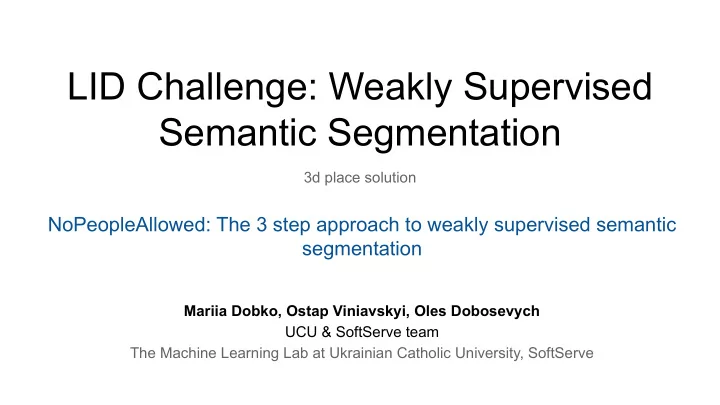

LID Challenge: Weakly Supervised Semantic Segmentation 3d place solution NoPeopleAllowed: The 3 step approach to weakly supervised semantic segmentation Mariia Dobko, Ostap Viniavskyi, Oles Dobosevych UCU & SoftServe team The Machine Learning Lab at Ukrainian Catholic University, SoftServe
Outline ● Problem description ● Competition ● Approach architecture ○ Step 1. CAM generation via classification ○ Step 2. IRNet for CAM improvements ○ Step 3. Segmentation ● Postprocessing ● Results ● Conclusions
Problem description Image-level annotations A key bottleneck in building a DCNN-based 15 times faster to label segmentation models is that they typically require pixel level annotated images during training. Acquiring such data demands an > 25 times cheaper expensive , and time-consuming effort. 0.035$ per image for class, 3.45$ for segmentation We develop a method that has a high performance in segmentation task while also saves time and expenses by using only image-level annotations .
LID Challenge Dataset ● Multilabel multiclass ● 200 classes + background ● Pixel-wise labels are provided for ● 456,567 training images validation set only ○ validation: 4,690 ● No pixel-wise annotations are ○ test: 10,000 allowed for training
Challenges ● High imbalance in classes: ‘person’, ‘bird’, ‘dog’ ● Missing labels ● Subset of 2014 has better labels for ‘person’, than the whole dataset
Previous works Expectation-Maximization methods Object Proposal Class Inference methods Multiple Instance Learning methods Self-Supervised Learning methods Chan et al. A Comprehensive Analysis of Weakly-Supervised Semantic Segmentation in Different Image Domains
Our approach architecture Multiscale CAM Classification GRADCAM IRNet Segmentation TTA CNN Dense CRF Step 1 Step 2 Step 3
Step 1. CAM generation via classification Input ● 72k - train, 12k validation ● balanced dataset ● no person class Results Zhou et al. Learning deep features for discriminative localization
Step 1. CAM generation via classification Tested approaches ● ResNet50 vs. VGG16 → ResNet produces artifacts ● VGG16 with additional 4 conv layers ● GRADCAM vs. GRADCAM++ → GRADCAM++ usually gives just slightly better results Chattopadhyay et al. Grad-CAM++: Improved Visual Explanations for Deep Convolutional Networks
Step 2. IRNet for CAM improvements Input ● Select most confident maps ● Threshold CAMs into confident BG, confident FG and unconfident regions Results Ahn et al. Weakly supervised learning of instance segmentation with inter-pixel relations.
IRNet IRNet’s two branches: 1 - learns the displacement field 2 - learns class boundaries Losses for Displacement Loss for class boundary detection fields (foreground & background) Ahn et al. Weakly supervised learning of instance segmentation with inter-pixel relations.
IRNet. Class Boundary Detection Ahn et al. Weakly supervised learning of instance segmentation with inter-pixel relations.
Step 3 - Segmentation DeepLab v3+ Input ● 352x352 input images ● Strong augmentations ● ~42k images for training Results Chen et al. Encoder-decoder with atrous separable convolution for semantic image segmentation.
Postprocessing scale=0.5 scale=1 scale=2 Image Horizontal flip TTA Test Time Augmentations are added after segmentation step. The combination of 2 types of different TTAs, with one having 3 parameters, result in total 6 predictions, which are averaged by mean.
Secret insights ● VGG is better for CAM generation as ResNet gives artifacts ● Decrease the output stride of VGG by removing some of the max pooling operations ● Confident and unconfident regions for IRNet ● Multiscale CAM give a large improvement ● Dense CRF doesn’t require training, helps to rectify boundaries ● TTA after segmentation step drastically improves the results ● Replace stride with dilation in DeepLabv3+ to decrease the output stride
Metrics Classification Quality Segmentation Quality ● F-1 score ● Mean IoU ● Pixel Accuracy ● Mean Accuracy Step 1. Classification Step 2-3. IRnet & Segmentation
Quantitative Results Model IRNet threshold TTA Person CAM Mean IoU No 36.65 No Validation set 0.3 39.64 Yes DeepLabv3+ encoder: Yes 39.80* Experiments with different ResNet50 architectures and No 37.11 parameters on the 3rd 0.5 Yes 39.58 step No No 36.14 DeepLabv3+ encoder: 0.5 ResNet101 Yes 37.15 * wasn’t submitted
Quantitative Results Test set: DeepLabv3+ + TTA (Horizontal Flip, Multi-scaling)
Open questions Different types of regularization added to the first step → Improve the classification Downsampling was used to balance data → Upsampling or combination of both should be tested Adding person class labels to the other steps of pipeline → Ability to provide better results for a class which is highly present in data, though severely mislabeled Mean IoU per class allows to obtain high score even when some classes are skipped → A different metric or combination of metrics should be chosen as a premier for this task
Thank you for attention! dobko_m@ucu.edu.ua viniavskyi@ucu.edu.ua dobosevych@ucu.edu.ua presentation
Recommend
More recommend